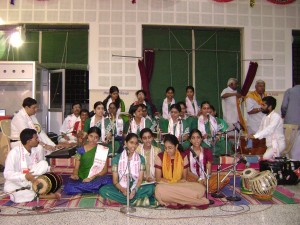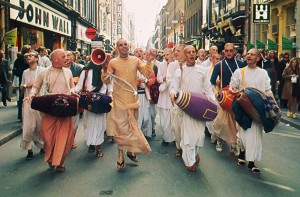
The words bhajana and kirtana both mean “to praise” or “to glorify,” therefore, a bhajan or a kirtan is the praising of a deity through song, music and dance. Hindus from different parts of India will use one term over the other, in much the same way that havan and homa are interchanged by devotees from different regions of India. Apart from praising a deity through song and music, bhajan can also have the added meaning of “spiritual practice.” A devotee, for example, may have a personal bhajan that he or she practices on a daily basis that may include puja, japa, study, meditation, prayer, and so on.
Used in the sense of praise and glorification, bhajana and kirtana involve a group of devotees coming together in a temple, hall or home, with musical instruments to sing the glories of a Deity or, more usually, many Deities. Bhajana and Kirtana are often preceded by a short puja for sanctification and to evoke the Deities who are the object of veneration. At the conclusion of bhajan and kirtan, prasada, food offered to the deity, is always distributed. Without this prasada the program is not complete.

Kirtana also has a variation called sankirtana which is the public praise and glorification of a Deity. Sankirtana parties, groups of devotees, go into the public areas of a city and walk down the streets or sit in the parks singing and chanting the names and a Deity. The Hare Krishna movement is famous for the performance of sankirtana in many Western cities. In India sankirtana is commonly performed by many other groups of devotees as well.